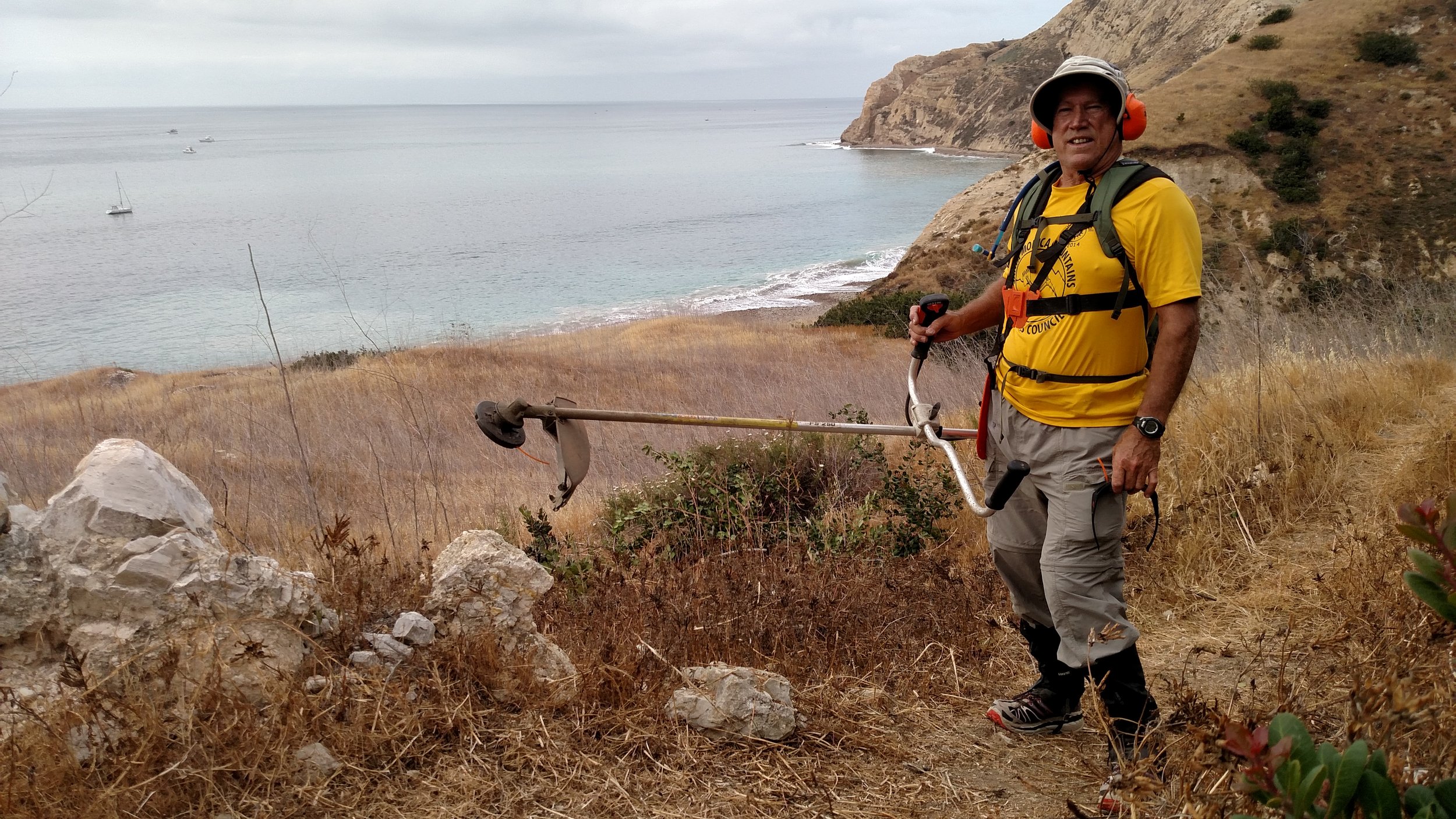One gets the sense that Dave Edwards is a man on a conservation mission. Having volunteered with Channel Islands Restoration since 2007 and a long-time board member since 2008, Dave has contributed hundreds of hours and led dozens of trips to the islands in the name of habitat restoration, trail maintenance and invasive species control. His work ethic and charming character have contributed to his close involvement with our organization, and he has become a figure of trust in the community. Although Dave will be leaving the board this year, his commitment to CIR will not falter and he seems more determined than ever to continue his work. We interviewed Dave to recognize his contributions over the years for the environment and our community.
Dave was born in Missouri, having spent his early years living in the Ozark Mountains and was always exposed to the outdoors. Dave recalls that his “family moved to north Texas where he went to high school and college, had a stint in the Marine Corps and retired from the Navy base at Port Hueneme where he provided logistical support for the Navy Seabees.”
When his career at Port Hueneme was over, Dave had more time to devote to the outdoors and landed on environmental volunteer work as a focus of his attention. Coincidentally, Dave’s first volunteer experience was with Channel Islands Restoration, joining primarily to have “more opportunities to visit the Channel Islands and help restore native plant habitation.” Dave first accompanied “CIR to Santa Cruz Island in February of 2007 to help eradicate hundreds of invasive eucalyptus trees in The Nature Conservancy’s central valley. Having made numerous trips to Santa Cruz Island since 1987, mostly on the eastern end, he couldn’t pass up an opportunity to visit the TNC side of the island which is off-limits to most visitors.”
From there, Dave was hooked on restoration. He describes how “rewarding trail work is knowing that our work makes the trails safer and more accessible to hikers, bikers and equestrians. Seeing what the trails look like before and after we clear them gives me a great deal of satisfaction. Invasive plants choke our trails in many areas and their removal allows for more native plants to take their place.”
Dave’s work preceded himself and “after about 4 or 5 volunteer trips to Santa Cruz Island to eradicate eucalyptus and vinca major, he was persuaded to join the board.” Dave recalls how “this was sometime during 2008. At that time CIR was sort of in its infancy and joining the board meant that I would be able to go to the islands more frequently. Since I was retired and I loved the outdoors, what a better way to spend my time.”
Dave quickly became a member of the “All Eight Club” someone who had stepped foot on each of the eight Channel Islands. He says his experiences gave him “the opportunity to appreciate all of the islands and their uniqueness. It’s always an adventure for me to set foot on any of the islands. I think most people feel that way.”
However, when it comes to memorable trips, Dave cites the two Navy controlled islands as “probably among the most memorable because of their remote locations and an adventure that few volunteers ever get to experience. The work on San Clemente Island involved eradicating ice plant and fennel and, although it was very hard work, was fun and enjoyable.” There, Dave helped build the native plant nursery on San Nicolas Island which was used to grow native plants from seeds collected from the island. “The Department of the Navy has a responsibility to the environment which they take very seriously, and I was able to help in a very small way in performing restoration work.” Dave also mentioned that being on Santa Cruz Island is always incredible as it “gives one a feeling of going back in time.”
His responsibilities within Channel Islands Restoration would continue to grow as a trip leader, educational guide, volunteer, and trail expert. His approach to tasks at hand all “require getting a crew together, coordinating the appropriate tools, and being aware of safety protocols. Each task is very different, but always coming in with a positive outcome is the goal.” Dave would become “part of the team that built the native plant shade house nurseries on San Nicolas and Anacapa islands, in Camarillo, and refurbished the existing one at the Greenwell Preserve in Summerland.”
Ultimately, the fruits of his labors are always rewarding regardless of the project. Dave mentions how “restoring the TNC’s Diablo Peak trail with a Sierra Club crew provided great views of the island and was a fun experience. I and others also led a Sierra Club crew cutting in the Chapel trail at the Main Ranch of TNC. Working on all these trails is very enjoyable for those who love the outdoors.” He strongly encourages “others who love the great outdoors to spend a little of their time doing volunteer trail work. Without volunteers the trails would soon become overgrown and impassable.”
Dave is also a key part of the Santa Monica Trails Council and explained that “the Santa Monica Mountains encompass five or so state parks from Point Mugu to Will Rogers State Historic Park in Santa Monica and relies almost entirely on volunteers to maintain its trails.”
He says although he will no longer be a board member of Channel Islands Restoration his “connection with CIR will not change in any way and that he will “continue to work with CIR in whatever capacity is appropriate.” Dave is looking forward to “more days outdoors, helping to restore, maintain and perhaps create trails.” In his own words, he hopes “to be able to continue to work outdoors as long as I am capable” and so far, it looks as if his enthusiasm for restoration and conservation hasn’t wavered.




